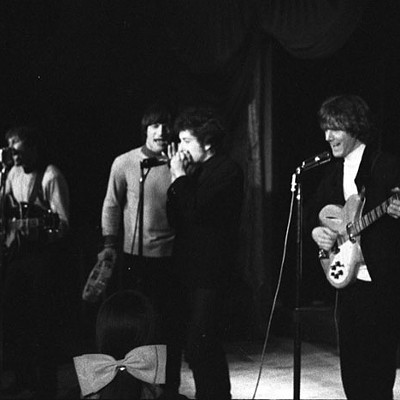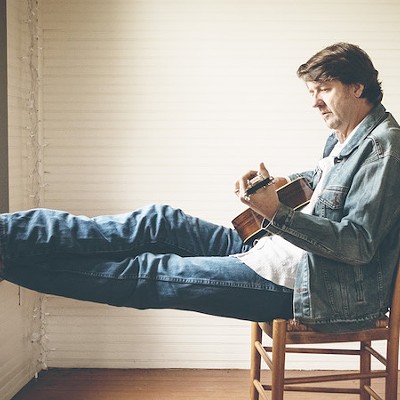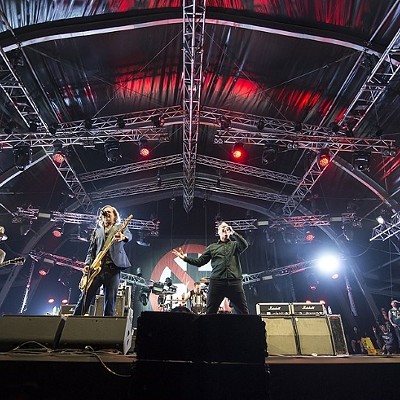Adam P. Newton recently became a father for the first time, so he has decided to explain the entirety of post-WWII Western pop music to his new daughter, "Fig": one genre at a time.
We’ve laid a good deal of groundwork to get this stage, Fig. The artists on this list couldn’t have created rock and roll without standing tall upon the shoulders of the folk, blues, country, jazz, and gospel greats that went before them. And to their credit, these artists regularly paid homage to their influences, even as they were building new fans and fanbases as they carved out these new sounds. In terms of musicology, you can hear exactly how we got to this point in 20th-century popular music — from the lyrics and tone to the arrangements and instrumentation. Rock took the lovelorn sensibilities of country, infused the raucous energy of the blues, and whipped it together with the affable to the average-ear chord progressions of folk and country. It was a match made in recording-history heaven — and, in some respects, things have never really changed.
If we wanted to be purists about it, some of the artists on this list fall more definitively into the “rockabilly” camp. But since “rock” is in the name, and because there was lots of cross-pollination with these folks in terms of touring, recording locales, and overall friendships, it’s easy to lump these trailblazers together into a single list.
Also, I would be remiss not to mention the impact of Sam Phillips and Sun Records on the birth of rock music. Going forward into other genres, it’s going to be tough to not mention the influence of record labels, executives, and producers in the development of a genre. For better or for worse, sometimes the people behind the scenes had an outsized role in what made a given singer, sound, or situation really rise in popularity.
BILL HALEY & HIS COMETS, “Rock Around the Clock”
While this track isn’t recognized as the “first” rock and roll single, it went a long way in pushing rockabilly and early rock music into wider circulation and recognition. Merging the country swing of Bob Wills with the Chicago blues of Muddy Waters into something catchy and perpetually danceable, Haley literally created the soundtrack for a generation. I mean, there’s a reason this track was the theme song for the first couple of seasons of Happy Days.
CHUCK BERRY, “Maybellene”
Hear that gritty guitar crunch and peppy tempo? Bands have been stealing this sound of for 60 years now. Then again, Berry borrowed it himself when he recorded it on Chess Records. The original was a Bob Wills tune called “Ida Red,” but Berry adapted it for guitar and recorded it with the encouragement of Muddy Waters. Noticing a theme here? It would have been easy to choose “Johnny B. Goode” because of the Back to the Future callback, but with this list I really do want to take you back to the roots of the genre.
ANTOINE "FATS" DOMINO, “Ain’t That a Shame”
With this track, we hear the influence of jazz and big band on the growth of rock music. Led by piano and horns, “Ain’t That a Shame” sent Fats Domino into the stratosphere as people fell in love with his New Orleans patois, rambunctious spirit, and rollicking piano styling. Like many of the songs on this list, people find the original by coming into contact with many popular covers, most notably efforts by Pat Boone and Cheap Trick.
LITTLE RICHARD, “Tutti Frutti”
This song will never grow old, and its opening scat phrasing make it instantly recognizable. Little Richard remains one of the most iconic personalities and inimitable showmen in the history of rock music. As you can hear on this and cuts like “Good Golly Miss Molly,” he made his name with a powerful tenor, falsetto wails, and aggressive piano technique. And it’s important to recognize how influential Richard, Domino, and Berry were in knocking down racial lines in music.
CARL PERKINS, “Blue Suede Shoes”
Another entrant into the rockabilly camp, Perkins was also part of the Sun Records family, a legendary recording studio in Memphis that launched the careers of three of the folks on this list, as well as Johnny Cash. Perkins was a stellar songwriter and guitar player whose work transcended genre and is more often recognized through covers recorded by other artists (including the next guy on this list). On this cut, you hear a gregarious voice, dexterous lead guitar solo, and swinging rhythm combined to fantastic effect.
ELVIS PRESLEY, “Heartbreak Hotel”
Obviously, “The King” was going to make this list but I wasn’t quite sure which song to include, since many of his big hits were recorded by other folks first (including the guy we just talked about). Presley wove equal parts country, blues and gospel into a compelling rockabilly whole that launched a thousand imitators and a million high-pitched squeals of female delight. Known for the swing of his hips, his magnificent hair, his sartorial choices later in life, and his appetites off the stage, Elvis was in his prime on “Heartbreak Hotel” — listen to that strong voice, tremendous vocal range, superb backing band, and utter sincerity of delivery. And while it’s become passé to complain about all the other artists and styles Elvis “stole” from during his meteoric rise to the top, he never failed to pay homage to those who came before him.
WANDA JACKSON, “I Gotta Know”
Dubbed the “Queen of Rockabilly” for her earnest and authentic take on a traditionally male-led genre, Jackson stood tall in the early days of rock music. She regularly toured with Elvis Presley, and she possessed a keen tenacity to blaze her own trail. One of her earliest hits, “I Gotta Know” straddles country and rock quite effortlessly, spending equal time as a lovelorn ballad and energetic brushoff, and you can easily hear the stage she capably set for the Dollys, Rebas, Trishas and Mirandas of the world.
JERRY LEE LEWIS, “Great Balls of Fire”
Yes, he married his 13-year-old cousin when he was 22, and yes, it tanked his career for several years because people were correctly and appropriately freaked out when they hear this news, but Lewis was a powerhouse of energy, attitude, and raw emotion. Whereas Presley sang sweet songs of love and romance (despite his shaking hips), Lewis brought the uncut and unfiltered sexuality of the blues into rock music - without any apologies. This might be my favorite track of his, but other folks swear by “Whole Lotta Shakin’ Going On” — and both proudly use lots of double entendre to complement Lewis’ teeth-rattling piano runs.
BUDDY HOLLY, “Peggy Sue”
Do you know what I like most about the music of Buddy Holly? I could literally visit cutting-edge indie music sites, flip to a college radio station, or tune into Sirius XMU right now and hear several handfuls of acts stealing vociferously from this bespectacled Texan’s aesthetic. His crisp, lean guitar perfectly complements his warbling tenor, while warm organ chords resonate underneath bright tom-tom rolls. Few artists shaped the tone and direction of rock music as it left the ‘50s and moved into the ‘60s. Sadly, Holly died in a plane crash on February 3rd, 1959, along with the last two folks on the list — “The Day the Music Died.”
J.P. “THE BIG BOPPER" RICHARDSON JR., “Chantilly Lace”
It’s kinda impossible to separate “The Big Bopper” from Holly and Valens because of the circumstances of their shared deaths, but his lasting influence as a musician pales in comparison to the others. Then again, when you examine the overtly flirtatious lyrical content of the song, it’s easy to hear his impact in the how ‘80s rock bands like Van Halen, Duran Duran, and Motley Crue talked to and about women.
RITCHIE VALENS, “La Bamba”
In a recording career that lasted less than one year, Valens recorded three of the best rock tracks of all time: “Come On, Let’s Go,” “Donna,” and the track for which he is most famous. His clear tenor intoned the words of a Mexican folk tule, while strong bass runs and syncopated percussions sent fingers snapping and toes tapping. And you cannot forget an absolutely iconic guitar riff, one that beginning guitar players have been learning for over 55 years. I truly wonder how rock music history might have been different had an innovative and popular Hispanic-American like Valens not died in 1959.
Up Next: the Growth of Pop Music of the ‘50s and ‘60s.
Support Us
Houston's independent source of
local news and culture
account
- Welcome,
Insider - Login
- My Account
- My Newsletters
- Contribute
- Contact Us
- Sign out
Explaining Grownup Music to Kids: The Birth of Rock and Roll
Adam P. Newton September 2, 2015 6:00AM
[
{
"name": "Related Stories / Support Us Combo",
"component": "11591218",
"insertPoint": "4",
"requiredCountToDisplay": "4"
},{
"name": "Air - Billboard - Inline Content",
"component": "11591214",
"insertPoint": "2/3",
"requiredCountToDisplay": "7"
},{
"name": "R1 - Beta - Mobile Only",
"component": "12287027",
"insertPoint": "8",
"requiredCountToDisplay": "8"
},{
"name": "Air - MediumRectangle - Inline Content - Mobile Display Size 2",
"component": "11591215",
"insertPoint": "12",
"requiredCountToDisplay": "12"
},{
"name": "Air - MediumRectangle - Inline Content - Mobile Display Size 2",
"component": "11591215",
"insertPoint": "4th",
"startingPoint": "16",
"requiredCountToDisplay": "12"
}
,{
"name": "RevContent - In Article",
"component": "12527128",
"insertPoint": "3/5",
"requiredCountToDisplay": "5"
}
]
KEEP THE HOUSTON PRESS FREE...
Since we started the Houston Press, it has been defined as the free, independent voice of Houston, and we'd like to keep it that way. With local media under siege, it's more important than ever for us to rally support behind funding our local journalism. You can help by participating in our "I Support" program, allowing us to keep offering readers access to our incisive coverage of local news, food and culture with no paywalls.
Adam P. Newton
Contact:
Adam P. Newton
Trending Music
- Country Rock Thrives with Gene Clark and Flying Burrito Brothers for Record Store Day
- Bruce Robison Is The Eternal Song Hunter
- Top 10 Butt-Rock Bands of All Time
-
Sponsored Content From: [%sponsoredBy%]
[%title%]

Don't Miss Out
SIGN UP for the latest
Music
news, free stuff and more!
Become a member to support the independent voice of Houston
and help keep the future of the Houston Press FREE
Use of this website constitutes acceptance of our
terms of use,
our cookies policy, and our
privacy policy
The Houston Press may earn a portion of sales from products & services purchased through links on our site from our
affiliate partners.
©2024
Houston Press, LP. All rights reserved.




